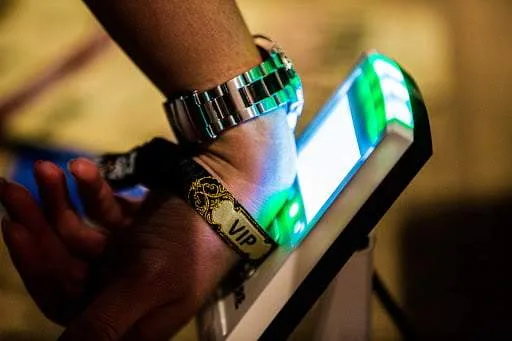With the growing need for mobile apps in a music festival, one company that’s not making a name for itself is Festival Technology. A San Francisco-based company has applied technology to several live events including the Coachella Music Fest in California.
It’s the brainchild of ex-MTV creative director, Chris Caple and his two colleagues, Jessica Koskoff and her partner Ryan Moran. With the help of Facebook, Twitter, YouTube, and other social media sites, they’ve created a new way for music festival goers to connect directly with the people who bring them to the events. But how did they get here?
RFID technology used at festivals and events
In an interview with Mashable, Jessica Koskoff, festival director of the Coachella Music Fest mentioned how festival technology helped the team create their unique online community.
“The idea behind this was really connecting with the music lovers, but we also wanted to provide a bridge for the festival goers as well,” she said. “What better way to do that than with rfid?” Rfid is short for radio-frequency identification, and it’s useful for a number of reasons,”
The Rfid technology allows the organisers to take advantage of RFID tags for data collection. Each person can be assigned a specific Rfid code, and when they come into contact with a festival attendee at any point during the event – whether it be at the merch table, the bar, or entry ways – their tags will be read and their data added.
This makes it possible for the festival to know if every ticket was sold and if every person had a wristband. The festival technology also provided an interface for festival goers to interact with each other. By taking a picture of a festival attendee, the web cam takes a snapshot of the attendee’s face so it can be included in the festival site.
Even though the festival technology hasn’t launched to mass market yet, there are already many festivals using Rfid technology for their entry ways and merchandise stands. Many festivals have used RFID at the entry ways for years.
The biggest obstacle was figuring out how to integrate the technology into crowds without inconveniencing festival goers who were accustomed to lining up and waiting in line. The solution was to have each person’s number tag attached to a p.1 tag reader that was mounted to the wall somewhere within the festival grounds. The p.1 tag reader could then pick up the frequency from the crowd, read it, and then relay it wirelessly to the wristbands that the attendees were wearing.
The two types of RFID
1. Low Frequency (LF) RFID
Low Frequency RFID (lfi) identification systems are used in conjunction with RFID tags, which are small chips made of non-conductive semiconductors which can store data. The tag is then scanned by an RFID reader and the stored data (ownership/ ownership claims, access control lists, etc) is stored on a computer chip.
The reader also transmits the data to the machine that uses the chip for recording and storing the data (a RFID tag reader). This RFID system is very similar to other types of RFID identification such as: RFID tag, radio frequency Identification (RFID), Global Positioning System (GPS) and wireless door locks.
Low Frequency RFID (lfi) identification systems are used in conjunction with smart labels. Smart Labels are strips of paper with embedded magnetic disks that are read by an RFID reader. When the reader “reads” the magnetic fields of the smart labels, the tag identifies the tag and authorizes the access. This type of system has applications in security, asset tracking, pharmaceutical and food safety and warehouse inventory control.
LF band covers frequencies from 30 KHz to 300 KHz
There are two low frequency RFID transponders available to businesses; passive rfid frequencies and active rfid frequencies. Passive RFID frequencies consist of a transmitter and antenna that are placed outside the secured area and which only transmits data when it is moving.
Active RFID frequencies consist of a transmitter, antenna and server that continuously transmit data to an access terminal that is located within the secured area.
2. High-Frequency (HF) RFID
High-frequency radio waves are those that are used for communication by radio operators using transceivers to detect the signals being sent out. RFID is short for radio frequency identification. This is a technology that allows electronic items to be tracked.
These items can be anything from car keys, glasses, wallets and more through an RFID tag. Some RFID systems are able to operate with only one frequency, while others are capable of tracking over a wider area with multiple frequency bands. RFID can operate on a single or multiple frequency band and it is possible to track multiple items with a single unit.
HF band ranges from 3 to 30 MHz. Most HF RFID systems will operate at 13.56 MHz
The lower frequency that is used is what is used in RFID tags. These RFID systems are very small and have the ability to fit in a shirt pocket and have a range of only a few feet. While they are not nearly as common as the high-frequency RFID tags, they are becoming more popular for a variety of reasons.
They are cheaper to manufacture and they allow for greater manufacturing flexibility since they do not need a separate power supply. One of the reasons they are becoming popular is because they are more efficient than the lower frequencies. They also give a better return on investment than the older systems.
The passive rfid tag reader works in the same way that an RFID tag reader does. It is capable of processing information from passive rfid tags and will need an external power source to operate. These readers work in the same way as RFID tag readers, but they are a bit smaller.
These readers were initially designed to be used to check for security issues with access control systems. As the technology behind RFID has advanced, these passive RFID tag readers have been adapted to work more efficiently and they have also been made to be more durable.
The integration of Rfid into festival goers’ personal data made the technology quite feasible. Once the technology was in place, festival goers could simply download their data to their computer, and log on to their personal Facebook or Twitter accounts to update their status whenever new information about the festival came out.
Once festival goers logged on to their social media pages, they saw not only new entries in their inboxes, but photos, videos, and tweets from friends and attendees. They also saw tweets from festival goers that complimented their festival experience and urged them to tweet about what they had experienced.
Once they started tweeting about the festival and the fun they were having, festival goers would soon see the popularity of their Twitter and Facebook account grow dramatically.
Another advantage to using RFID technology to gather personal data and disseminate that data are that smart devices are much easier to use than RFID readers. A person doesn’t have to line up at a computer, wait for an electronic ticket to be scanned, and then write down that ticket in order to take it home with him/her; a smart device can do all of those things for you.
For many festivals and events organizing teams, this is the real edge of the technology: smart devices give organizers immediate access to personal data which can be used to make decisions about staffing, ticket sales, and merchandising, and more







